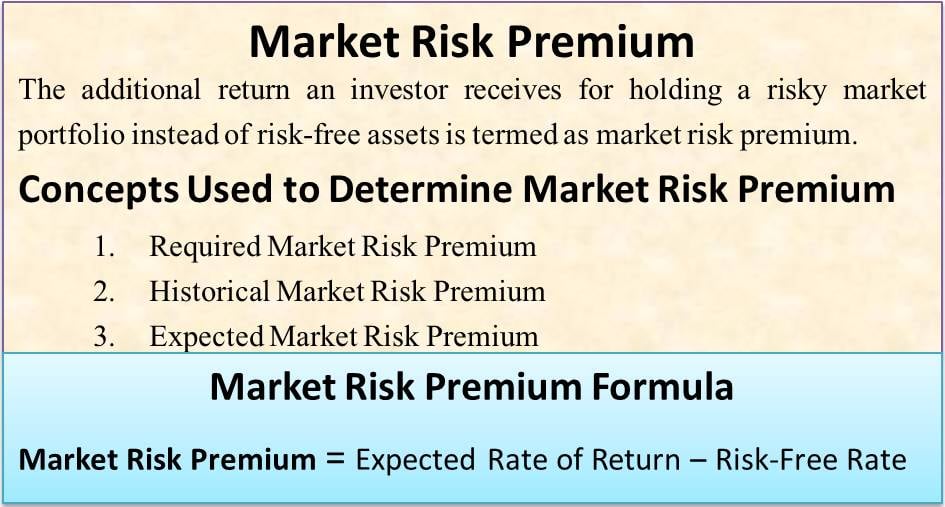Meaning of Market Risk Premium
The additional return an investor receives for holding a risky market portfolio instead of risk-free assets is termed as a market risk premium. Analysts and investors use the Capital Asset Pricing Model (CAPM) to calculate the acceptable rate of return. The market risk premium is an essential part of CAPM.
Market Risk Premium Formula
The formula for calculating the current market risk premium is:
Market Risk Premium = Expected Rate of Return – Risk-Free Rate
For calculation, you can use the Market Risk Premium Calculator
Let’s look at the concepts used to determine the same.
Concepts Used to Determine Market Risk Premium
The following are the three concepts related to the market risk premium:
Required Market Risk Premium
The minimum amount of return the investors should accept is known as a required market risk premium. The investor will not invest if the investment’s rate of return is lower than the required rate of return. This is also termed a hurdle rate.
Historical Market Risk Premium
This is the term given to the measurement of an investment’s past returns. Investment instruments can be used to measure the premium delivered by the specific investment. The historical premium helps the investors in determining the performance of the investment.
Expected Market Risk Premium
The expected market risk premium is the expectation of returns an investor has from an investment.
The results of required or expected market risk premiums would vary from one investor to another. The investor performs the calculations depending on the cost of equity required to acquire the investment.
Also Read: Equity Risk Premium

However, the results of historical market risk premium would be the same for all investors as its calculations are based on the past performances of an investment.
Example of Market Risk Premium
Let us understand this concept using an example: Suppose that Stock X gives a return of 7%, and the risk-free rate of return is 2%. Risk-Free Rate of Return is generally the US Treasury Bonds Rate for a maturity of 7-10 years.
Market Risk Premium = 7% – 2% = 5%
Interpretation of Market Risk Premium
Analysts use the CAPM (Capital Asset Pricing Model) to calculate an acceptable rate of return. The market risk premium is an important part of this. Investors invest with the highest rate of return and the lowest risk, and this remains the ideal situation. In practical circumstances, however, this ideal rate is not always available. Therefore, an investor must take this as the reference rate. And depending on the borrower’s risk-bearing capacity and creditworthiness, he must strive to obtain a rate of return close to this reference rate from the various available options.
Cautions
It only says the additional amount that investors receive when investing in a risky market portfolio rather than in risk-free assets. It does not say what amount investors accept for investing in risky assets or, in other words, what should be acceptable to the investor or lender. Another important point is that all investment decisions are not based solely on this additional return or market risk premium. There are so many other factors that ultimately determine whether they invest or not. These are quantum of investments, investment period, return on investment, financial strength, future prospects of the business model, security of punctual payments, the status of other borrowings and thus the adequacy or excess of leverage status, and so on.
Also Read: Market Risk Premium Calculator
Conclusion
Investors are inclined towards investments with the highest possible return rate combined with the lowest possible risk. A market risk premium is a significant element of discounted cash flow valuation and modern portfolio theory. It assists the investor in making an appropriate decision on how to gain maximum out of their investments.
RELATED POSTS
- Risk-Adjusted Discount Rate Calculator
- Maturity Risk Premium – Meaning, Need, Formula and Interpretation
- How is the Interest Rate related to the Required Rate of Return, Discount Rates, and Opportunity Cost?
- Maturity Risk Premium Calculator
- Cost of Equity – Capital Asset Pricing Model (CAPM)
- SML vs CAL

